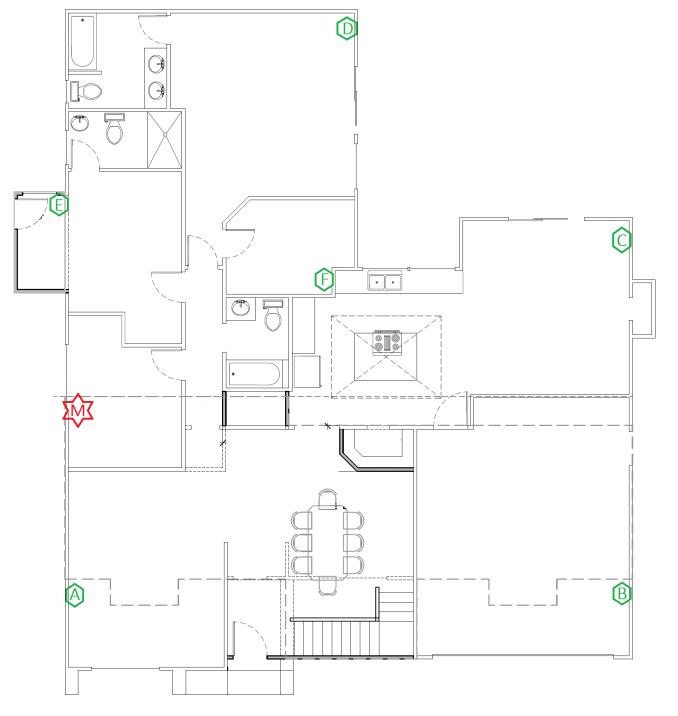Comtrend PG-9172 Powerline Adapter Review: G.hn Gets Primed for Retail Push
by Ganesh T S on May 3, 2016 8:30 AM EST- Posted in
- Powerline Adapters
- Networking
- Marvell
- G.hn
- HomePlug
- Comtrend
Evaluation Setup and Testing Methodology
G.hn's claims of being better than HomePlug AV2 in real-world scenarios was always something we had wanted to test out for ourselves. In order to evaluate the claims, we took out all the powerline adapters that had come in for review over the last four years and subjected all of them to the same iperf benchmarks under the same conditions across different power outlets in a residence. Prior to going into the details of the evaluation, let us take a look at the features of the different powerline adapters being considered today.
| Comparative PLC Configurations | ||
| Aspect | Comtrend PG-9172 | |
| Technology | G.hn | HomePlug AV2 |
| Chipset | Marvell 88LX3142 for G.hn Digital Baseband Marvell 88LX2718 Analog Front End |
Qualcomm Atheros QCA7500 |
| Encryption | 128-bit AES | 128-bit AES |
| Performance | 1200 Mbps (PHY) / 1000 Mbps | 1000 Mbps (PHY) / 1033 Mbps (AV2 MIMO Powerline 0 - 65 MHz Theoretical Max.) |
| Miscellaneous Features | MIMO (Multiple Input Multiple Output) G.hn / HPAV Co-existence Technology |
MIMO (Multiple Input Multiple Output) |
| Dimensions | 93mm x 59.6mm x 35mm | 90mm x 60mm x 27mm |
| Weight | 100g | 95g |
| Retail Availability | May 2015 | December 2014 |
| Current Street Price (Kit) | USD 77 | USD 83 |
All the testing was carried out in a 1800 sq. ft. single-level detached California residence built in the 1970s. The rough floorplan of the house, along with the testing locations, is presented below.
The evaluation of the adapters was done in an isolated network. A NUC with an Intel NIC (running Windows 10 Pro x64) was configured to act as a DHCP server, and placed at location 'M' (in red) in the above picture. The 'master node' powerline adapter was connected to it. Yet another NUC with an Intel NIC (running Windows 10 Pro x64) was connected to the other adapter in the network. The location of this NUC / adapter combination was varied for each adapter pair's evaluation run. We considered typical powerline adapter usage scenarios in deciding upon the locations for the testing (A - F in green in the picture above). All major rooms, including the garage, were covered.
The purpose of our benchmarking was not to tune the stream configuration for obtaining maximum possible bandwidth. Rather, we wanted to replay the same stream for multiple adapter sets in order to determine comparative performance. iperf with default parameters was used for benchmarking. On the 'server', we ran the following command:
TCP: iperf -s -B 10.1.1.2
UDP: iperf -s -u -B 10.1.1.2
The 'client' was connected to it using the following command:
TCP: iperf -c 10.1.1.2 -P ${num_parallel_streams} -t 30
UDP: iperf -c 10.1.1.2 -u -b ${curr_bw_to_test}m -t 30
The number of parallel streams were tested between 20 and 25 for the TCP case. The maximum obtained bandwidth was recorded. For the UDP case, we altered the bandwidth to test in order to arrive at the value that resulted in less than 1% packet loss during transmission. The roles of the server and client were then reversed, and the same benchmarks were processed.












48 Comments
View All Comments
bigboxes - Tuesday, May 3, 2016 - link
Agreed. I was able to infer that they were the same, but yes it was confusing.geniekid - Tuesday, May 3, 2016 - link
+1.spawnbsd - Tuesday, May 3, 2016 - link
HomeGrid forum is just an organization that promotes G.hn, that's all. Many of the equipment and chipset vendors building G.hn gear belong to HomeGrid forum.sor - Wednesday, May 4, 2016 - link
+1, sounds like three different competing standards in the article.Icehawk - Tuesday, May 3, 2016 - link
What is idle power after turning power saving on?mgrier - Tuesday, May 3, 2016 - link
Any chance I could get you to test latency also? This is important for competitive gamers...gobaers - Tuesday, May 3, 2016 - link
I just did a ping sweep on my Homeplug connection:Reply to request 4861 (1 ms) (size 997)
Reply to request 4862 (10 ms) (size 998)
Reply to request 4863 (10 ms) (size 999)
Reply to request 4864 (1 ms) (size 1000)
Success rate is 100 percent (4865/4865), round-trip min/avg/max = 1/5/30 ms
Mostly 1ms, but can sometimes spike. I wonder if G.hn handles this better.
spawnbsd - Tuesday, May 3, 2016 - link
Marvell's G.hn chipsets use G.hn's TDMA MAC mode, and generally always given lower (more determinstic) latency and throughput compared to CSMA based HomePlug AV/AV2 gear. Latency should always be in the ~1ms range, unless impulse noise or other interference in the home forces link layer retransmissions (which will add jitter).qlum - Tuesday, May 3, 2016 - link
I wonder how the performance of these devices differs under the European 230v/50hz compared to the us.Murloc - Thursday, May 5, 2016 - link
they're just as much finicky and dependent on where you put them in although there is no weird old wiring in most european houses.